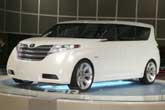Recent Articles
Popular Makes
Body Types
Car Brief: Toyota F3R Concept
Another reason to skip theaters and arcades

Minivans don’t need to be boring. At least, that’s what Toyota hopes to convey with the F3R Concept vehicle that debuted at the 2006 North American International Auto Show in Detroit, what the company claims is “a sporty extension of a concept all but forgotten in today’s automotive world.” Sporty minivans are nothing new. Mazda sells one today called the MPV. Dodge, Ford, and Pontiac have all sold minivans with performance themes – anyone recall the awful Montana Thunder with its fake hood scoops? Still, there’s no denying that the minivan market has stagnated at about half a million sales per year, mainly because younger consumers won’t be caught dead in them. Such is youthful American vanity. The reality, as those who’ve taken the leap have discovered, is that no vehicle for sale today is more practical for daily living – especially when you’ve got kids, pets, and a home to maintain. To prove that a people-mover can be appealing, Toyota’s California design studio, Calty Design Research Inc., was given a simple but clear directive to create a three-row concept car that is roomy, responsive, stylish, and environmentally responsible. The result is the Toyota F3R Concept. To appeal to younger buyers, designers decided to create “a relaxed lounge environment” for the Toyota F3R Concept’s interior because the target market uses a car as an entertainment hang-out. Therefore, the F3R gets eight modern seats with metal-edged bottoms and asymmetrical backs. The driver’s seat swivels to face the second and third rows, while the front passenger’s seat reclines into a chaise. In the second-row, the right two sections of the 40/20/40 middle seats fold into the floor, while the left portion reclines to meet the third row and create an L-shaped sofa. Once the F3R is configured to be a mobile lounge, occupants can deploy two track-mounted flat-panel video screens for movies or gaming, controlled with a remote that detaches from the dashboard for use in the “lounge” area. If lounging around in your car isn’t your style, you could use the Toyota F3R Concept as a family vehicle with forward-facing stadium-style seats (including a second-row center “front and center” child seat that can be moved closer to the front of the car), three entry and exit doors on each side, and seats that can stow individually to maximize cargo capacity. Exterior design was critical to the success of the Toyota F3R Concept. The vehicle needed to be big inside, but it also needed to be sleek outside. The result is a bold, sculpted, wedge-shaped body with a face full of “J-factor.” J-factor refers to design elements culled from Japanese culture that Americans might also find appealing, and the F3R Concept’s nose is uniquely robust. As a design study, the Toyota F3R Concept has no powertrain under its hood, but the vehicle wears Hybrid Synergy Drive badges to indicate that the company’s gasoline-electric technology would be used to propel the massive 22-inch wheels. In keeping with the F3R Concept’s theme of environmental responsibility, the floor panels are made of Ecoresin, a recyclable resin, and the seats are upholstered in simulated leather called Mythos. We find the Toyota F3R Concept fascinating, the first real breakthrough in minivan design since that first Dodge Caravan rolled off the assembly line in 1983 (though the awful plastic GM future-mobiles of the early 1990s at least innovative). Just one problem, though. A big selling point of a minivan is the sliding doors on both sides of the car. It seems that Toyota may have overlooked function in favor of form, at least on one fundamental point.
Photos courtesy of Toyota